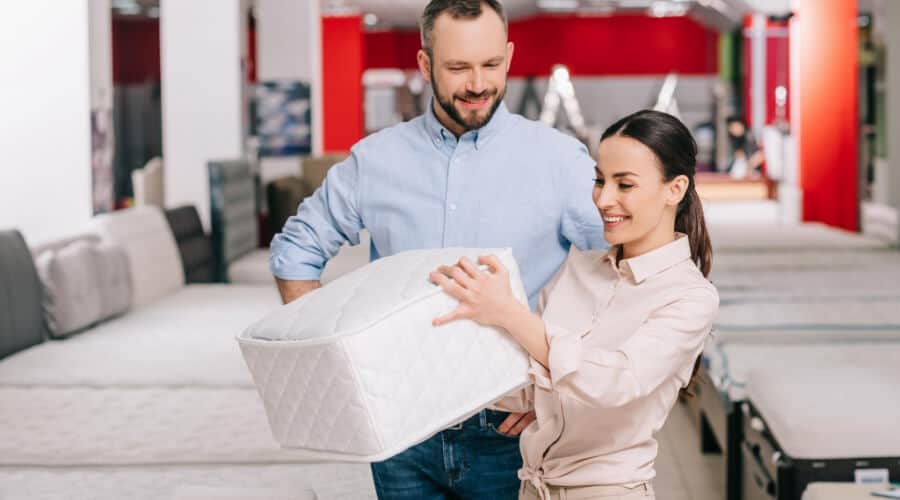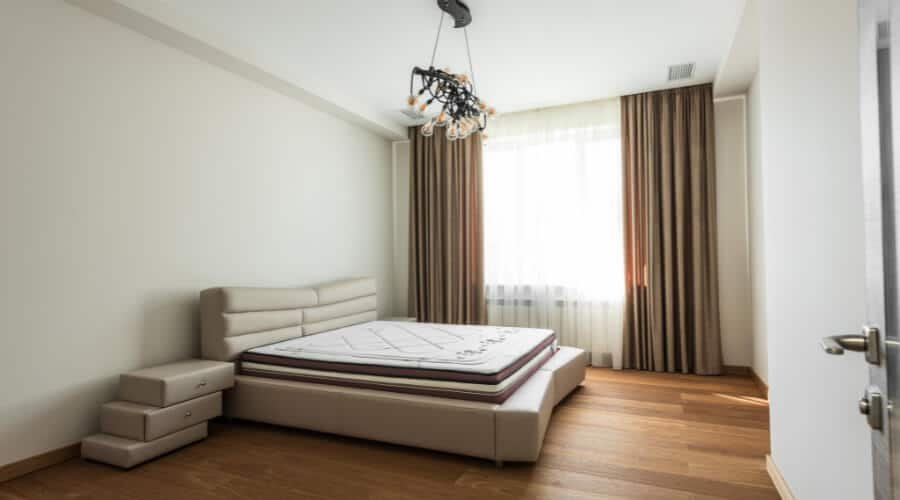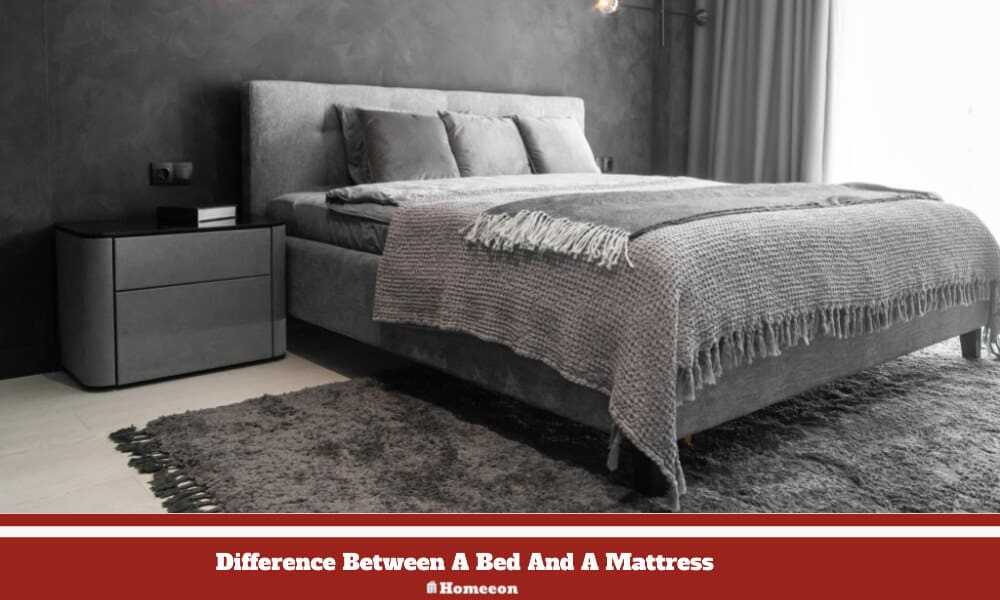Last Updated on July 25, 2023 By Emma W. Thomas
A bed refers to the entire furniture piece used for sleeping, including the frame, headboard, and footboard. A mattress, on the other hand, is the specific component that provides comfort and support for sleeping. The mattress sits on the bed frame and is an essential part of the sleeping setup.
The Main Difference Between A Bed And A Mattress
| Bed | Mattress |
|---|---|
| A bed refers to a piece of furniture that provides a place to sleep or rest. | A mattress is the actual component of the bed that offers support and comfort to the body. |
| Beds generally consist of a frame, headboard, footboard, and slats to support the mattress. | Mattresses are typically composed of multiple layers, such as foam, springs, or a combination, to provide comfort and support. |
| Beds are available in various sizes, such as twin, full, queen, and king, to accommodate different sleeping needs. | Mattresses also come in different sizes corresponding to the bed size, and they can range from twin to California king. |
| Beds can have additional features, including storage drawers, adjustable bases, or built-in lighting. | Mattresses, on the other hand, focus solely on providing a comfortable surface for sleep and do not usually include extra features. |
| Beds can be made from different materials, such as wood, metal, or upholstered fabric. | Mattresses may have different types of covers, such as fabric or vinyl, but the internal construction mainly determines the comfort and support they provide. |
| Beds are typically seen as a complete sleeping solution that includes the mattress, frame, and other components. | Mattresses are arguably the most crucial element of a bed and can be used with or without a traditional bed frame. |
What is A Bed?
A bed is a piece of furniture designed for sleeping or resting. It typically consists of a frame that supports a mattress, along with a headboard and footboard for decorative and structural purposes. Beds come in various sizes and styles to accommodate different needs and preferences for sleeping comfort.
What is A Mattress?
A mattress is a thick, rectangular pad made of various materials, designed to provide comfort and support for sleeping or resting. It is placed on top of a bed frame and is an essential component for a good night’s sleep. Mattresses come in different types, such as memory foam, innerspring, latex, and hybrid, catering to different sleep preferences and needs.
What Are The Main Types Of Mattresses?

There are three major types of mattresses, namely, innerspring, foam, and bladder pieces. Each of these units has its unique features, for example;
Foam Mattresses
These mattresses use varying densities and weights of viscoelastic, latex rubber, memory, or polyurethane foams, all of which are petrochemical-based and flexible. Some producers also combine viscoelastic and polyurethane elastic foams with plant-based materials while pairing platform bases with all-foam mattresses.
Memory Foam
This type of mattress is made using compact viscoelastic foam instead of polyurethane-based foam which is firmer. The manufacturers vary the thickness, formulation, and weight of the viscoelastic foams to achieve varying levels of comfort and feel.
Memory foam mattresses are ideal for those looking forward to relieving pressure from painful joints. The beds are costly as compared to their standard spring counterparts, and they conform to different temperatures. For example, they become softer and adapt to the body temperature and weight of the user, and get firmer in a cold room than a warm one.
Latex Foam
Latex foam is a blend of synthetic and natural rubber (from the Hevea brasiliensis tree). This latex is derived from fillers, petrochemicals, and other substances but, there are also latex mattresses with no polyurethane-based chemicals.
These mattresses are lighter, go back to their initial shape faster than foam mattresses, and respond to the user’s movements. While the mattress does not adapt to the sleeper’s body, it contours to the weight and shape.
High-Density Foam
High-density foam mattresses are made from polyurethane, which is a more compact foam. High-density foam is made from tightly packed open cells, making it denser than other types of foam. Some of these mattresses have an innerspring system that makes them comfortable and long-lasting.
Differences Between Latex And Memory Foam Mattresses
Memory foam | Latex foam |
Supports weight and pressure points and conforms to the body shape | Responds to the body movements |
Low-density lasts 4-6 years, high-density lasts 8-10 years. | Latex blends last 6-8 years, all-natural latex lasts 8-10 years. |
Prevents minor pains and aches | Relieves spine and back pains |
Warmer | Cooler |
Innerspring Mattresses

These types of mattresses comprise spring cores, top, and bottom padding covers. The middle point of the mattress is made up of coils or steel coil springs, and it supports the user’s body. These coils are linked via interconnecting wires, which help the mattress retain its shape and the gauge of the coils determines the amount of support and firmness.
There are different types of mattress coils, including;
Offset
Offset coils have flattened top and bottom portions that are hinged together using helical wires. Hinging of the springs helps the unit to adapt to the body shape creating a feeling of comfort.
Marshall Coils
These coils are also referred to as pocket springs, wrapped, or encased coils. They are barrel-shaped, knotless, and have a thin gauge. Each ring is usually covered in synthetic material from non-woven fiber. Some loops may be pre-compressed to make the mattress firmer and allow separation of movement between the bedsides.
Since coils are not linked together, they work independently with individual weights, not affecting the others.
Continuous Coils
Continuous coil (also known as Mira-coil) has rows. In this innerspring pattern, coils are arranged in rows and formed from one piece of wire. The rings are hinged together to create a hinging effect like in offset coils.
Bonnell Coils
These springs are the oldest but most preferred in mid-priced mattresses. They are hourglass-shaped, knotted, and round-topped steel wire coils. The springs are joined together using cross-wire helicals to create a simple innerspring piece known as the Bonnell unit.
Bladder Mattresses
This type of mattress is made from bladders filled with air or water, and they date back to 3600 BCE. These pieces were popular in Persia, where goatskins bladders were filled with water and used as beds. In the 20th century, bladder mattresses became more popular with improved production. There are two types of these items, namely;
Waterbeds
A waterbed mattress consists of water instead of air or coils in its interior. It is also lined with layers of fiber which makes it firm and comfortable to the user. Like other mattresses, this kind of bed provides support to the body parts, especially the spine.
Air Mattresses
Air mattresses use at least one air chamber to offer support instead of using springs. There are both inexpensive options (used for camping) and quality, high-end luxury mattresses. Air bladder design can range from a simple polyethylene bag to an internally baffled piece with several chambers of vulcanized rubber (latex). It can also have vinyl with linked cotton interiors.
These mattresses could have layers of foam on top of the air chambers for extra cushioning and could also be placed inside a cover. Several air mattress models range from basic no-frills (7-inches high) to high-profile (15-inches tall) hybrids. These beds may contain different pillow tops, foam, and digital pumps with memory to help in pressure settings.
Adjustable-firmness mattresses are ideal for medical use since they have unique control features and are perfect for back pains. There are also self-adjusting mattresses that inflate and deflate different air chambers automatically and help with bedsores (decubitus ulcers). Camping air beds contain foam that expands and lets in the air when the valve is opened and inflates itself. With this mattress, campers do not have to carry pumps.
Factors To Consider When Purchasing A Mattress
Various factors need to be considered when purchasing a mattress to provide comfort, which includes;
Design
A standard mattress consists of two essential parts, i.e., the support (core) layer, and the upholstery (comfort) layer. Ensure that the bed you purchase offers the maximum level of support and comfort.
The Right Size
Mattresses come in different sizes and are designed to fit standard beds. Their sizes vary between national dimensions in height, depth, and width, with most countries using terms such as ‘full,‘ ‘single,‘ ‘double,‘ ‘king,‘ or ‘queen.‘ Choosing the right size of mattress for your bed is crucial for the provision of comfort and support.
Quality
The mattresses’ quality depends on hygiene, edge support, stability, and pressure distribution. A mattress’s firmness is also crucial in the quality of sleep that the user gets. Ensure that you get the right mattress that suits your sleeping style and provides the support and firmness you desire.
Lifespan
A mattress should be as long-lasting as possible to give you value for money. It also needs to retain its original comfort and support for an extended period. Be sure to consider the materials, quality of manufacture, care requirements, and rigorousness of use. Quality latex pieces can last over 20-years; the innerspring core goes for over 10-years, while poor-quality foam may not go beyond 1-year.
What Are The Different Bed Designs?
Beds come in different designs, including;
Platform Beds
These beds have wooden slats or a support design that doesn’t need a box-spring mattress.
Low-Profile Bed
A low profile is the most common type of bed in the contemporary world. Its low-profile design feature defines this piece as it is close to the ground. This bed typically requires a box-spring mattress and is perfect for short individuals. A low-profile bed also makes a room look more extensive as it creates a wide-open feel.
Panel Bed
This kind of bed features a footboard and headboard (both of which are wooden). These items are decorated with panel slats made of wood. Sometimes the bed may come with microfiber stuffing or entrenched leatherette. There are different shades of this bed, including cappuccino, oak cherry, white, and other dark wood hues.
Bunk Bed
Two beds are stacked together to form a bunk bed. These beds are popular among children, teens, and college-going youth. The different designs include full over full, twin over full, and twin over twin.
Trundle
This type of bed is a roll-out bed that is easily movable and goes underneath the bed. A majority of these pieces of furniture are twin size which is either wooden or metallic. The bed is ideal for hosting guests at night, and one can add them to other types such as captain and bunk beds.
Captain
A captain bed features a headboard with shelf storage ideal for decorative items like books and alarm clocks. One can also store pillows and blankets below the headboard or a trundle under the bed for guests sleeping over. Captain beds come in different shades such as navy blue, oak, black, white, birch, pecan, and walnut.
Conclusion
Both beds and mattresses are used for sleeping on or for resting. You can place a mattress on the floor and use it without a bed. But, you need a mattress as part of the bed for it to be comfortable. There are different types of beds and mattresses and what you chose determines the level of comfort and support you get.
References:
https://www.creditdonkey.com/bed-vs-mattress.html
https://difference.guru/difference-between-bed-and-mattress/
Emma is a graduate of Domestic Science or Family and Consumer Sciences (Home Economics) from the University of Wisconsin. She has 7 years of experience Working with the strategic section of BestBuy and now writing full-time for Homeeon.
From Managing the Home, Interiors, Cleaning, and Exteriors to Gardening and everything about Making A Home Liveable – is her passion and this Homeeon is the result of this.
Emma loves decorating her home with the best stuff found online. She cares about quality over anything and writes reviews about them here in Homeeon. Get in touch with her over Pinterest.
Keep reading her blogs.

